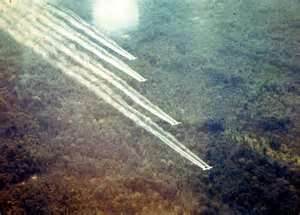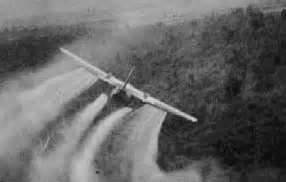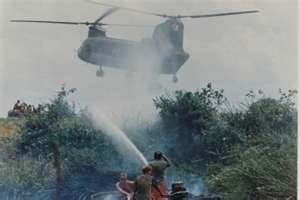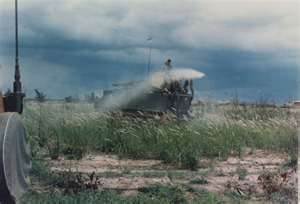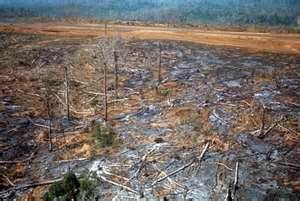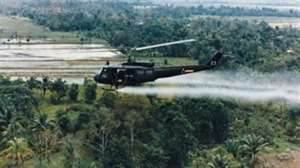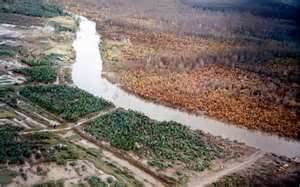


U.S. Dept. of Veterans Affairs - October 26, 2022
Military Exposures --
Agent Orange --
Facts about Herbicides --
Beyond Agent Orange - Other Herbicides
AO and Presumptive Conditions
Military Exposures --
Agent Orange --
Facts about Herbicides --
Beyond Agent Orange - Other Herbicides
AO and Presumptive Conditions
Agent Orange is a blend of tactical herbicides the U.S. military sprayed from 1962 to 1971 during Operation Ranch Hand in the Vietnam War to remove trees and dense tropical foliage that provided enemy cover.
More than 19 million gallons of various “rainbow” herbicide combinations were sprayed, but Agent Orange was the combination the U.S. military used most often. The name “Agent Orange” came from the orange identifying stripe used on the 55-gallon drums in which it was stored.
Heavy sprayed areas included forests near the demarcation zone, forests at the junction of the borders of Cambodia, Laos, and South Vietnam, and mangroves on the southernmost peninsula of Vietnam and along shipping channels southeast of Saigon.
The U.S. Department of Defense developed these tactical herbicides specifically to be used in “combat operations.” They were not commercial grade herbicides purchased from chemical companies and sent to Vietnam. Tactical herbicides also were used, tested, and stored in areas outside of Vietnam.
Learn how Veterans may have been exposed to Agent Orange and other herbicides during military service, including outside Vietnam.
Agent Orange active ingredients and characteristics
The two active ingredients in the Agent Orange herbicide combination were equal amounts of 2,4-dichlorophenoxyacetic acid (2,4-D) and 2,4,5-trichlorophenoxyacetic acid (2,4,5-T), which contained traces of 2,3,7,8-tetrachlorodibenzo-p-dioxin (TCDD).
The dioxin TCDD was an unwanted byproduct of herbicide production. Dioxins are pollutants that are released into the environment by burning waste, diesel exhaust, chemical manufacturing, and other processes. TCDD is the most toxic of the dioxins, and is classified as a human carcinogen by the Environmental Protection Agency.
Agent Orange dries quickly after spraying and breaks down within hours to days when exposed to sunlight (if not bound chemically to a biological surface such as soil, leaves and grass) and is no longer harmful.
For more information on TCDD, read the fact sheet on chlorinated dibenzo-p-dioxins (63 KB, PDF) from the Agency for Toxic Substances and Disease.
More than 19 million gallons of various “rainbow” herbicide combinations were sprayed, but Agent Orange was the combination the U.S. military used most often. The name “Agent Orange” came from the orange identifying stripe used on the 55-gallon drums in which it was stored.
Heavy sprayed areas included forests near the demarcation zone, forests at the junction of the borders of Cambodia, Laos, and South Vietnam, and mangroves on the southernmost peninsula of Vietnam and along shipping channels southeast of Saigon.
The U.S. Department of Defense developed these tactical herbicides specifically to be used in “combat operations.” They were not commercial grade herbicides purchased from chemical companies and sent to Vietnam. Tactical herbicides also were used, tested, and stored in areas outside of Vietnam.
Learn how Veterans may have been exposed to Agent Orange and other herbicides during military service, including outside Vietnam.
Agent Orange active ingredients and characteristics
The two active ingredients in the Agent Orange herbicide combination were equal amounts of 2,4-dichlorophenoxyacetic acid (2,4-D) and 2,4,5-trichlorophenoxyacetic acid (2,4,5-T), which contained traces of 2,3,7,8-tetrachlorodibenzo-p-dioxin (TCDD).
The dioxin TCDD was an unwanted byproduct of herbicide production. Dioxins are pollutants that are released into the environment by burning waste, diesel exhaust, chemical manufacturing, and other processes. TCDD is the most toxic of the dioxins, and is classified as a human carcinogen by the Environmental Protection Agency.
Agent Orange dries quickly after spraying and breaks down within hours to days when exposed to sunlight (if not bound chemically to a biological surface such as soil, leaves and grass) and is no longer harmful.
For more information on TCDD, read the fact sheet on chlorinated dibenzo-p-dioxins (63 KB, PDF) from the Agency for Toxic Substances and Disease.
Agent Orange Newsletter - Octobeer 2022
The PACT ACT and Vietnam Veterans
The Honoring our Promise to Address Comprehensive Toxics Act of 2022, or PACT Act, will help Veterans in the areas of care for military exposures, presumptions, and research. For Veterans who served nobly in Vietnam or elsewhere where Agent Orange may have affected them, the PACT Act:
Adds hypertension and the laboratory test finding of monoclonal gammopathy of undetermined significance (MGUS), which can be a precursor for the development of multiple myeloma in some cases, as presumptions.
Adds several locations to the areas eligible for Agent Orange presumptions, including Guam, American Samoa, and Laos; and increased coverage in Thailand.
The Honoring our Promise to Address Comprehensive Toxics Act of 2022, or PACT Act, will help Veterans in the areas of care for military exposures, presumptions, and research. For Veterans who served nobly in Vietnam or elsewhere where Agent Orange may have affected them, the PACT Act:
Adds hypertension and the laboratory test finding of monoclonal gammopathy of undetermined significance (MGUS), which can be a precursor for the development of multiple myeloma in some cases, as presumptions.
Adds several locations to the areas eligible for Agent Orange presumptions, including Guam, American Samoa, and Laos; and increased coverage in Thailand.
Beyond Agent Orange: Other Tactical Herbicides
From 1962 to 1971, during Operation Ranch Hand in Vietnam, the U.S. Air Force sprayed tactical herbicides for control of vegetation. These herbicides were named based on the color of their barrels. During the war, around 20 million gallons of Agents Green, Pink, Purple, Blue, White, Orange, Orange II, Orange III, and Super Orange were sprayed in South Vietnam.
Below is information on some of the other herbicides besides Agent Orange that were used:
3 planes spray herbicides
Agent Blue - (cacodylic acid) was an arsenic-based chemical used to destroy rice. About 4 million gallons were sprayed. Among the current presumptions, bladder cancer might be most directly associated with potential exposure to this herbicide.
Agent Purple – consisted only of 2,4,5-T, which is the chemical that was contaminated with dioxin as a byproduct. About 500,000 gallons of Agent Purple were sprayed.
Agent White – was a 4:1 mixture of 2,4-D and picloram. About 5 million gallons were sprayed, some after the cessation of Agent Orange spraying.
Since many chemical agents were used as tactical herbicides, and since we are not able to measure exposure to these agents adequately, it is difficult to attribute specific health conditions to these chemical agents.
From 1962 to 1971, during Operation Ranch Hand in Vietnam, the U.S. Air Force sprayed tactical herbicides for control of vegetation. These herbicides were named based on the color of their barrels. During the war, around 20 million gallons of Agents Green, Pink, Purple, Blue, White, Orange, Orange II, Orange III, and Super Orange were sprayed in South Vietnam.
Below is information on some of the other herbicides besides Agent Orange that were used:
3 planes spray herbicides
Agent Blue - (cacodylic acid) was an arsenic-based chemical used to destroy rice. About 4 million gallons were sprayed. Among the current presumptions, bladder cancer might be most directly associated with potential exposure to this herbicide.
Agent Purple – consisted only of 2,4,5-T, which is the chemical that was contaminated with dioxin as a byproduct. About 500,000 gallons of Agent Purple were sprayed.
Agent White – was a 4:1 mixture of 2,4-D and picloram. About 5 million gallons were sprayed, some after the cessation of Agent Orange spraying.
Since many chemical agents were used as tactical herbicides, and since we are not able to measure exposure to these agents adequately, it is difficult to attribute specific health conditions to these chemical agents.
Agent Orange and Presumptive Conditions
Vietnam Veterans are automatically presumed to have been exposed to herbicides during their service and are qualified for certain VA benefits. There are specific medical conditions presumed to be related to Agent Orange exposure.
They are:
AL Amyloidosis
Chronic B-cell Leukemias
Chloracne
Diabetes Mellitus Type 2
Hypertension
Hodgkin’s Disease
Ischemic Heart Disease
Monoclonal gammopathy of undetermined significance (MGUS)
Multiple Myeloma
Non-Hodgkin’s Lymphoma
Parkinson’s Disease
Peripheral Neuropathy, Early- Onset
Porphyria Cutanea Tarda
Prostate Cancer
Respiratory Cancers
Soft Tissue Sarcomas.
With the Fiscal Year 2021 National Defense Authorization Act, VA added three new conditions to the presumptive conditions to the list:
Bladder cancer
Hypothyroidism
Parkinsonism (also known as Parkinson-like conditions)
Vietnam Veterans are automatically presumed to have been exposed to herbicides during their service and are qualified for certain VA benefits. There are specific medical conditions presumed to be related to Agent Orange exposure.
They are:
AL Amyloidosis
Chronic B-cell Leukemias
Chloracne
Diabetes Mellitus Type 2
Hypertension
Hodgkin’s Disease
Ischemic Heart Disease
Monoclonal gammopathy of undetermined significance (MGUS)
Multiple Myeloma
Non-Hodgkin’s Lymphoma
Parkinson’s Disease
Peripheral Neuropathy, Early- Onset
Porphyria Cutanea Tarda
Prostate Cancer
Respiratory Cancers
Soft Tissue Sarcomas.
With the Fiscal Year 2021 National Defense Authorization Act, VA added three new conditions to the presumptive conditions to the list:
Bladder cancer
Hypothyroidism
Parkinsonism (also known as Parkinson-like conditions)




